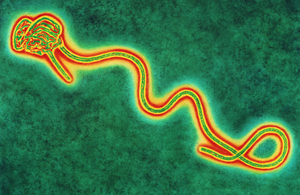PHE study finds Ebola virus mutated slower than first thought
Scientists find Ebola virus' mutation rate only slightly higher than previous outbreaks.

The Ebola virus responsible for the outbreak in West Africa mutated at a similar rate to previous outbreaks, according to a new international study led by Public Health England (PHE) and published today (18 June 2015) in Nature.
Early in the outbreak, research suggested the virus’ mutation rate was twice that of previous Ebola outbreaks. However, PHE’s study has established that the mutation rate was only slightly higher than previous outbreaks, which is reassuring to public health experts around the world.
Granted unprecedented access to data covering a period of almost a year, the scientists analysed 179 patient samples obtained by the European Mobile Laboratory (EMLab), which was deployed to the epicentre of the outbreak in Guinea, to reveal how the Ebola virus mutated and spread.
The analysis confirmed that the Ebola virus was introduced into the Guinean population in December 2013 at a single source, supporting theories from epidemiologists (scientists who investigate the spread of disease). Scientists believe the virus was initially transmitted from a bat to a 2 year old boy in Guinea.
The team also established how the virus spilled into Sierra Leone from Guinea in April or early May 2014. Notably, a large number of the early cases in different regions of Sierra Leone can be linked to a single funeral.
Lead author Professor Miles Carroll, Head of Research Microbiology Services for PHE, said:
Our analysis shows the Ebola virus responsible for the current outbreak mutated at a similar rate to the earlier outbreaks in Uganda and the Democratic Republic of Congo. The results are good news for the scientists working to develop long-term solutions for Ebola, such as vaccines and treatments, as it means these new interventions should still work against the mutated strains of the virus. Currently, rehydration and replacement of critical elements appear to be the best way to improve a patient’s chances of surviving Ebola.
Following this study, we have theorised that one of the key factors in whether Ebola kills someone is the host’s genetic makeup rather than changes in the virus itself. Our next study will investigate this theory which may lead to improved treatment options.
We would like to acknowledge the collaborative efforts of a great many colleagues who worked on this study here in the UK and across the European Union and in Africa. In particular, this work was an opportunity to transfer skills and knowledge to our colleagues in Guinea as an investment in the public health infrastructure of the region.
Professor David Heymann, PHE Chairman and of Infectious Disease Epidemiology at the London School of Hygiene and Tropical Medicine, said:
This project, funded by the European Commission, illustrates how international collaboration is the most effective way to progress our understanding of new emerging diseases and develop innovative public health treatments and vaccines.
PHE are supporting global efforts to find the best diagnostic, vaccine and treatment options for Ebola. This research is reassuring to scientists and the public that the recent work on Ebola has been worthwhile and could soon lead to a better state of preparedness and response for the future.
Background
-
The article reference is: Carroll et al. (2015). Temporal and spatial analysis of the 2014-2015 Ebola virus outbreak in West Africa. Nature.
-
The study involved 132 scientists from 50 organisations across the UK and European Union, and included scientists based at the EMLab in Guinea, Liberia and Sierra Leone. In addition to personnel from the Health Guinean Authorities, World Health Organisation (WHO) and Médecins Sans Frontières (MSF).
-
PHE exists to protect and improve the nation’s health and wellbeing, and reduce health inequalities. It does this through world-class science, knowledge and intelligence, advocacy, partnerships and the delivery of specialist public health services. PHE is an operationally autonomous executive agency of the Department of Health. www.gov.uk/phe. Twitter: @PHE_uk, Facebook: www.facebook.com/PublicHealthEngland
-
The EMLab is a consortium of laboratories located throughout the EU that specialise in working with dangerous viruses like Ebola. They received a grant from the EC in 2012 to develop three mobile units for the diagnosis of outbreak diseases in Africa and Europe. In March 2014 EMLab scientists were the first to be deployed to the epicentre of the Ebola outbreak in Gueckedou. EMLab worked closely with MSF for 1 year until the Gueckedou region was declared free from Ebola. The EMLab is co-ordinated by Prof Stephan Gunther from the Bernard Nocht Institute in Hamburg. This study was supported by a research grant from the EC that funds the subsequent analysis of the diagnostics material. The research arm of EMLab is called EVIDENT.
-
The genetic fingerprinting capability for Ebola virus has been in development for several years in collaboration with the study co-authors; Prof. Julian Hiscox and colleagues at the University of Bristol led by Dr David Matthews. The genetic analysis component of the study was led by Dr Mike Elmore (PHE), Dr Georgios Poliakis (Liverpool University) and Prof Andrew Rambaut (Edinburgh University).
-
The financial support for the study was provided by a €1.8 million grant awarded by the European Union to the research arm of the EMLab, EVIDENT, which is co-ordinated by Professor Stephan Gunther from the Bernard Nocht Institute in Germany. For more information, visit: evident-project.eu